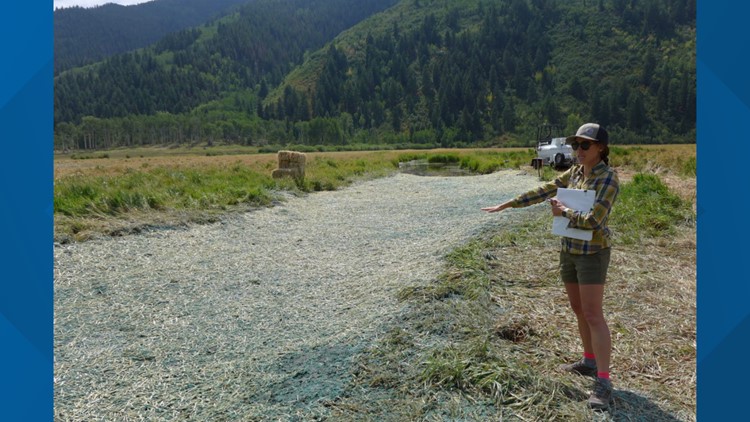ASPEN, Colo. — On a recent morning, Liza Mitchell of Pitkin County Open Space and Trails rolled out fiber mats over a soil-filled portion of a ditch in the North Star Nature Preserve, adding a final layer to a wetland plug that the natural resource planner and ecologist and her team had been working on for the three weeks prior.
The plug is the central component of the program’s fen-restoration project, which aims to enhance the wetland’s ability to provide habitat, store and filter groundwater, and sequester carbon.
While North Star is known as an idyllic paddleboarding and beach destination, 77% of the preserve is closed to public access. This includes the property west of the Roaring Fork River, where the fen sits.
This story is powered by COLab, the Colorado News Collaborative. 9NEWS joined this historic collaboration with more than 40 other newsrooms across Colorado to better serve the public.
The preserve’s 245 acres function primarily to protect native species and ecosystems. The first 175 acres of the preserve were bought by the Nature Conservancy in 1977. In 2001, Pitkin County Open Space and Trails and the city of Aspen jointly purchased the 70 acres below the initial property, creating the current North Star Nature Preserve, according to the 2020 North Star management plan.
“It’s for wildlife,” Mitchell said of North Star.
Critical to the nature preserve
Aligning with the goal of conservation, Open Space and Trails staff identified the North Star fen as a site for ecological restoration. Situated in the northwest corner of the property, the 14-acre fen, which is a peat-filled wetland, is populated with sedges, reeds and grasses.
The wetland is critical to the entire preserve, providing wildlife habitat, water filtration and flood mitigation. In dry months, groundwater stored in the fen percolates into the Roaring Fork River, benefiting the watershed and its thirsty users, Mitchell said.
Yet, due to human alterations to the watershed and North Star, the fen is drying out. In 1936, two tunnels, multiple canals, and the Grizzly and Lost Man reservoirs were completed as part of the Independence Pass Trans-Mountain Diversion System. The system moves water from the upper Roaring Fork River basin to the east side of the Continental Divide, satisfying the water needs of Colorado’s largest cities, according to the 2020 management plan.
This system diverts as much as 40% of the Roaring Fork’s headwaters upstream of the preserve, reducing the volume of river water that flows into the property and saturates the fen, Mitchell said.
The fen underwent further drying in the 1950s, when the preserve was a private ranch owned by James Smith. Smith dug ditches through the fen for pasture and hay cultivation, and those ditches continue to drain standing water into the Roaring Fork, according to Mitchell.
The wetland plug combats the drying by slowing the outflow of water from the fen into the Roaring Fork River. Mitchell, two staffers from Basalt-based Diggin It Riverworks and two ecological consultants began the plug construction Aug. 10. The first week, the team filled 130 feet of the main ditch with a mixture of locally sourced and imported soil. In the second and third weeks, the team added a layer of local soil, scattered native plant seeds and sealed it all with hay, mulch and matting, Mitchell said.
“It’s been a pretty quick project,” she said. “We’ve really tried to get in, get out and minimize disturbance as much as possible.”
6,700 years of carbon sequestration
The wetland plug increases saturated conditions in the fen, or the presence of standing water, enhancing the fen’s ability to provide ecological services to the preserve. For instance, saturated conditions allow fens to function as carbon sequesters by storing peat, or carbon-rich plant material.
Peat accumulates at a rate of 8 inches per 1,000 years, according to David Cooper, wetland ecologist and professor at Colorado State University. With 53 inches of peat soil, the North Star fen is estimated to be 6,700 years old, according to a Pitkin County news release.
“Peatlands make up about 5% of the land surface of the world,” Cooper said, “but almost 45% to 50% of all the soil carbon on Earth is in peatlands.” When fens dry up, the carbon stored as peat is released as carbon dioxide, contributing to global warming, he said.
Saturated conditions also support wildlife. Standing water creates the ideal habitat for native plants, such as beaked and blister sedge, as well as native amphibians and waterfowl. Saturated conditions suffocate canary grass, an invasive species that spread increasingly through the fen as it dries up, Mitchell said.
Wet by standing water, fens filter groundwater. The peat body removes excess nitrogen as well as heavy metals that would otherwise accumulate in watershed fish populations, Cooper said.
A positive for North Star neighbors
Mitchell anticipated finishing the construction phase of the restoration project this past week. She plans to place wattles, or cylinders of hay, across the wetland plug to prevent soil and seed erosion. She also will add hay bales and cylinders to the fen’s two smaller ditches to retain water and provide a surface for native plants.
After this construction phase, a hydrologist and botanist hired by Open Space and Trails will monitor the fen for three years. The consultants will conduct studies and submit reports to the U.S. Army Corps of Engineers, which issued the initial permit for the project in 2018, according to Mitchell.
In the spring of 2021, Open Space and Trails staffers hope to get the local community involved with the project by having volunteers plant native sedges and rushes over the plug.
Already, community response to the restoration project has been very positive. Even without physical access to the fen, neighbors are excited about the prospect of improving habitat for wildlife, such as blue heron and elk, which they enjoy watching from their windows, Mitchell said.
“North Star can get a lot of negative attention surrounding the paddleboarding and recreation use, so it’s really nice to have another project that there seems to be widespread agreement on,” Mitchell said. “Everyone can get behind that it’s a pretty light touch for a pretty big benefit.”
Aspen Journalism is a local, nonprofit, investigative news organization covering water and rivers. For more, go to aspenjournalism.org.
RELATED: Colorado 14er attempts dropped in summer 2019 due to snowpack, avalanche debris, report finds
SUGGESTED VIDEOS: Colorado Guide



